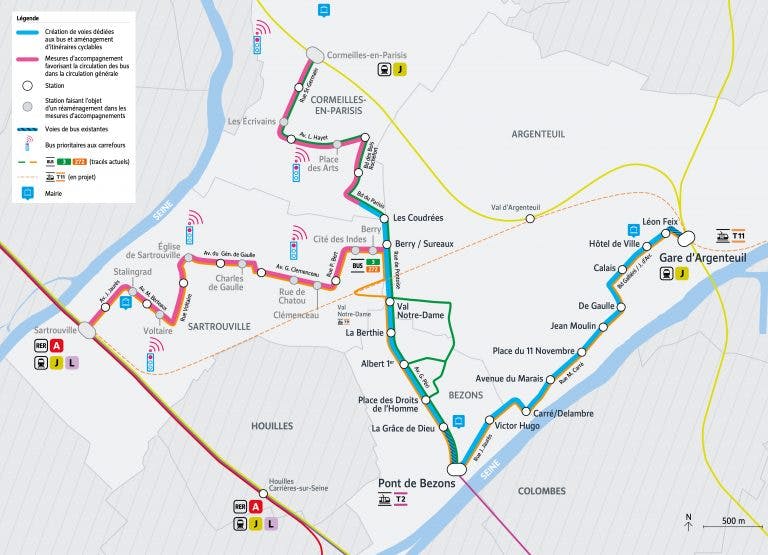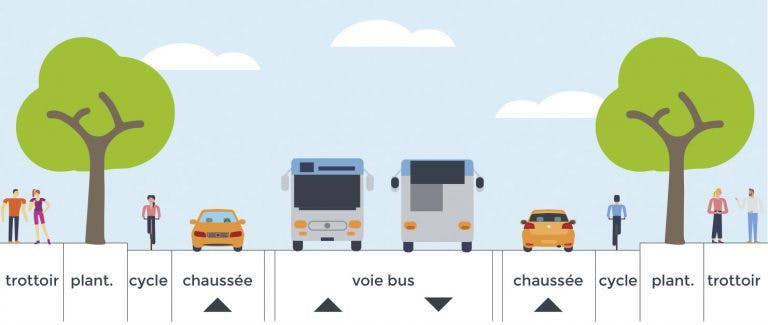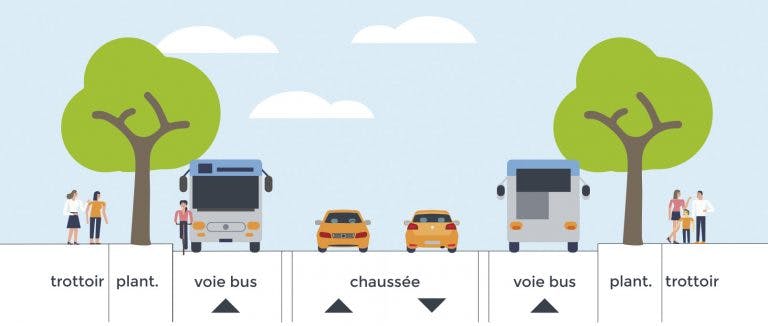The project at a glance
Why this project?
Located between two arms of the Seine, the territory of Argenteuil, Bezons, Sartrouville and Cormeilles-en-Parisis is marked by areas dense in housing and jobs, but poorly served by structuring public transport, in particular:
- the city centre of Argenteuil and the Val Notre Dame district,
- the heart of the city of Bezons,
- the Quartier des Indes in Sartrouville,
- the Bois-Rochefort sector in Cormeilles-en-Parisis.
Many bus lines run through this territory but suffer from difficult traffic conditions, especially during rush hour.
The Bus Entre Seine project aims to improve passenger travel in the area, in particular by developing dedicated bus lanes. It will thus improve the regularity of the lines and reduce travel times between the Bezons bridge (T2 tramway) and the stations of Argenteuil (Transilien J), Sartrouville (RER A, Transilien L) and Cormeilles-en-Parisis (Transilien J).
The development of reserved bus lanes will be accompanied by a requalification of public spaces, including the creation of cycle routes and landscaping for a better quality of life: trees, widened pavements, etc.
This project is linked to urban planning and transport policies in a rapidly changing territory. The sector, densely populated and rich in business hubs, will develop further by 2030. This is why the public transport offer must adapt and respond as best as possible to future developments while developing soft modes of transport.

What developments?
The creation of dedicated bus lanes
Dedicated bus lanes will be set up from Argenteuil station to Pont de Bezons, then to the Les Indes district (Sartrouville) and the Bois-Rochefort sector (Cormeilles) via Avenue Gabriel Péri and Rue Lucien Sampaix (RD392). These will mainly be two-way bus lanes, and from time to time, buses will be able to benefit from bus lanes in one direction only, or even use general traffic.

On these 8.2 km, the circulation of the lines will be considerably improved with more regular and faster buses. In parallel with the bus lanes, cycle routes will be created and the comfort of pedestrian paths will be improved.


Accompanying measures to the stations of Cormeilles and Sartrouville
In Sartrouville, between the Route de Pontoise and the RER station, accompanying measures will be proposed to facilitate bus traffic:
- implementation of priority at traffic lights, which will turn green when buses arrive;
- development of the main resorts;
- intervention at certain intersections, which will be specified in future studies, to facilitate bus traffic.
In Cormeilles-en-Parisis, buses will also benefit from these accompanying measures between the Boulevard des Bois-Rochefort and the station.
Which bus lines are affected?
The project concerns the bus links between Argenteuil station, the Pont de Bezons, Sartrouville station and Cormeilles-en-Parisis station.
Line 272 (Argenteuil station – Sartrouville RER) and line 3 (Pont de Bezons – La Frette-sur-Seine) are particularly affected. They will use the new bus lanes for most of their route.
Other bus lines will be able to use the facilities from time to time. The route of some lines will be reworked in order to take full advantage of the new developments and with the aim of improving the entire bus network.
What timetable?
The preliminary consultation, conducted from 19 March to 20 April 2018, was the first stage of dialogue on the project with the public. It gave rise to a report on the consultation, approved by the Île-de-France Mobilités Council.
The technical studies have continued, taking into account the lessons learned from the consultation. The public was again consulted on the basis of a more detailed draft as part of a public inquiry, which took place from 6 November to 11 December 2021. The project owner has published its project declaration which takes into account the reservations of the investigating commissioner in the pursuit of the project. From now on, the Prefect must decide on the declaration of public utility of the project.
Once the project has been declared of public utility, detailed studies will be carried out, as well as the necessary land acquisitions to widen the roads and allow the project to be carried out.
On average, there are about 8 to 10 years between the prior consultation and the commissioning of this type of infrastructure (subject to the implementation of funding and administrative authorisations).